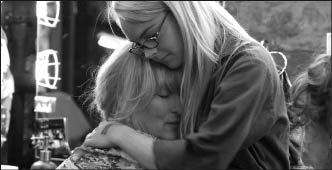From Beautiful Downtown Saint Paul...
by George Sax

“Nobody looks back in radio,” Garrison Keillor says at one point in the new film named for his 32-year-old NPR radio show, Prairie Home Companion. “That’s the beauty of it.”
Which is kind of laughable, in its way. His show is nothing if not a faux-nostalgic exercise, part parody of, part homage to American-heartland, mid-century radio variety programs. It seems to echo some Arthur Godfrey and a little Henry Morgan. It’s built around Keillor’s own artfully frumpy persona, and his roundabout, often curiously telling wit.
The good news here is that Keillor, who wrote the film (with Ken LaZebnik) at director Robert Altman’s instigation, is even more effective as a movie performer than as a radio personality. His half-amused, owlishly observant, slightly perplexed posture works with quiet authority on screen. He’s even more obviously a skilled comic actor here than on radio. One is moved to call up that old bromidic tribute, “He’s a natural.”
Keillor performances often seem to allude to comedian Fred Allen and the “Allen’s Alley” segment of his 1940s radio show. And to Algonquin Round Table humorist and movie actor Robert Benchley, with his carefully modulated nonsense. There are echoes of the unthreatening yokel sharpies Will Rogers and Mark Twain and the American tall tales tradition, along with hints of W.C. Fields. In this film, Keillor doesn’t even seem to be playing himself; he seems to be playing a character sharing his name.
What’s significantly, and a little distressingly, less successful is his scripting job. He’s got a gift for sketches, and for looping, shaggy-dog dialogue, and they’re woven into the movie, sometimes enhanced by Altman’s multi-layered directing approach and sometimes not.
At first, I thought that the film’s failings might be more Altman’s responsibility—that his involuting, avoid-the-dramatic-arc style, which has become more mannered as the years have passed, had undercut Keillor’s material. But by the time Prairie Home coasted to a halt, it was clearer that Keillor hadn’t shaped it to begin with.
He’s strung a lot of engaging business together on a whimsical wisp of a narrative and tried to punch it up with a couple of awkwardly imposed devices. He may have needed a strong-minded, old-movie-hand collaborator.
The slight narrative conceit is that we’re watching and listening to the last broadcast of Keillor’s radio show because its home base, Saint Paul’s Fitzgerald Theatre, has been sold to a developer-magnate (Tommy Lee Jones) and the radio folk are being evicted.
Altman has assembled a cast of the sort that wouldn’t be possible for virtually anyone else. Meryl Streep and Lily Tomlin are Rhonda and Yolanda, the singing Johnson sisters. (I forget who was which.) Kevin Kline is Keillor’s doggedly anachronistic radio gumshoe, Guy Noir (“Saint Paul is the city…Keillor has been on the air since Jesus was in the third grade”), and he’s winningly loose and goofy, with his own touch of Fields.
Woody Harrelson and John C. Reilly are a pair of strenuously burlesqued cowboy warblers. (They and several of the other cast members do cockamamie covers of folk and country tunes.) There are too many fine performances to note; everyone’s is a semi-precious gem.
If you let yourself go with the meandering flow, keep your expectations in check and don’t mind much when Prairie Home winds down without having gone anywhere in particular, its cultivation of its own offbeat bent can be mildly satisfying.
On my way out of the theater, an employee was saying to someone, “There has to be something between X-Men and Prairie Home.” If those really are the poles (and I’m not so sure) it won’t hurt to spend time at Keillor’s end of the spectrum.
|
Issue Navigation> Issue Index > v5n23: Greed and the Demolition of the H-O Oats Elevator (6/8/06) > Film Reviews > From Beautiful Downtown Saint Paul... This Week's Issue • Artvoice Daily • Artvoice TV • Events Calendar • Classifieds |









 Current Issue
Current Issue